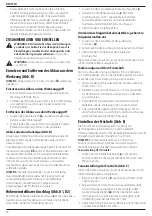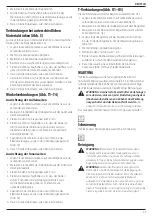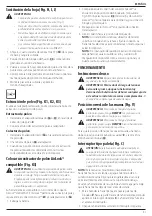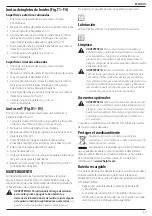
40
EngLIsh
Assembling the Workpieces
1. Try assembling the workpieces together to check that the
joints fit correctly.
2. Evenly spread a suitable glue in the biscuit slots and on the
mating surfaces of the joint.
3. Insert the biscuits into the slots, ensuring that they come
into contact with the glue.
4. Assemble the workpieces and clamp them until the glue
has dried.
Edge to Edge Joints (Fig. P1, P2)
1. Place the workpieces on a flat surface as they are to
be assembled.
2. Mark the biscuit centres. The biscuits should be located at
15–25 cm intervals; the outer biscuits should be located
5–7.5 cm from the ends of the workpiece (Fig. P1).
3. Set the fence to 90 °.
4. Set the height adjuster to position the biscuit in the centre
of the workpiece.
5. Adjust the other tool settings as described above.
6. Cut the biscuit slots as described above (Fig. P2).
Frame Joints (Fig. Q1–Q3)
1. Place the workpieces on a flat surface as they are to be
assembled (Fig. Q1, Q2).
2. Select the appropriate biscuit size.
3. Mark the biscuit centres.
4. Adjust the tool settings as described above.
5. Cut the biscuit slots as described above (Fig. Q3).
Corner Joints (Fig. R1, R2)
1. Arrange the workpieces as they are to be assembled
(Fig. R1).
2. Select the appropriate biscuit size.
3. Mark the biscuit centres.
4. For the face cut, clamp the workpiece and align the tool as
shown (Fig. R2)
5. Cut the biscuit slots as described above.
Offset Joints (Fig. S)
When joining two workpieces of different thickness, proceed
as follows:
1. Arrange the workpieces as they are to be assembled.
2. Select the appropriate biscuit size.
3. Mark the biscuit centres.
4. Select the workpiece that will be set back.
5. Set the height adjuster to position the biscuit in the centre
of the workpiece.
Locating the Biscuits (Fig. N1–N4)
For edge joints, biscuits should normally be located at 15–25 cm
intervals.The outer biscuits should be located 5–7.5 cm from the
ends of the workpiece (Fig. N1).
When joining narrow workpieces such as picture frames, even
the smallest biscuits may be too large for the joint. In this case,
the exposed tip of the biscuit should be trimmed off after the
joint has been glued (Fig. N2).
When joining workpieces thicker than approx. 2.5 cm, pairs of
biscuits may be used for additional strength (Fig. N3).
To mark mating pieces, first position them as they will be
assembled. Use a set square to draw the marking line across the
pieces (Fig. N4).
Cutting Biscuit Slots (Fig. O)
1. Adjust the tool settings as described above.
2. Align the centre marking on the tool base with the marking
line as shown.
3. Switch the tool on and wait a second for the cutter attain
full speed.
Making Biscuit Joints (Fig. L–O)
WARNING:
Always make a trial cut in a piece of
scrap wood to check the plunge depth. If necessary,
perform a fine adjustment as described in
Assembly
& Adjustments
.
Various techniques can be used to make strong and accurate
biscuit joints. In this manual, the most important techniques will
be discussed in more detail (Fig. L).
Selecting the Biscuit Size (Fig. M)
The three biscuit sizes are #0, #10 and #20. Normally, you should
use the largest biscuit that will fit in the workpiece.
After selecting the size of biscuit to be used, adjust the
plunge depth accordingly as described under
Plunge
Depth Adjustment
.
No‑Volt
The No‑volt function stops the biscuit jointer from restarting
without the switch being cycled if there is a break in the
power supply.
Paddle Switch (Fig. C)
CAUTION:
Hold the auxiliary handle and body of the
tool firmly to maintain control of the tool at start up and
during use and until the blade stops rotating. Make sure
the blade has come to a complete stop be fore laying the
tool down.
nOtE:
To reduce unexpected tool movement, do not switch
the tool on or off while under load conditions. Allow the biscuit
jointer to run up to full speed before touching the work surface.
Lift the tool from the surface before turning the tool off. Allow
the tool to stop rotating before putting it down.
1. To turn the tool on, push the lock‑off lever
2
toward the
back of the tool, then depress the paddle switch
1
. The tool
will run while the switch is depressed.
2. Turn the tool off by releasing the paddle switch.
4. Firmly push the fence against the workpiece and plunge the
cutter until the stop is reached.
5. Allow the tool to retract the blade from the workpiece.
6. Turn the tool off.
Summary of Contents for XR DCW682
Page 1: ...DCW682 ...
Page 3: ...1 Fig A 3 4 5 8 7 11 1 6 9 12 13 2 Fig B 12 14 12 13 XXXX XX XX 20 10 13 ...
Page 4: ...2 Fig C Fig D1 Fig D2 Fig E Fig F Fig G Fig H Fig I 1 11 8 6 6 9 4 2 15 7 23 ...
Page 6: ...4 5 7 5 cm 15 25 cm 15 25 cm Fig N3 Fig N4 Fig O Fig P1 Fig P2 Fig Q1 Fig Q2 Fig Q3 ...
Page 7: ...5 Fig R1 Fig R2 Fig S Fig T1 Fig T4 Fig U1 Fig T2 Fig T3 ...
Page 8: ...6 Fig U2 Fig U3 Fig U4 Fig U5 Fig V 3 19 ...
Page 163: ......
















































